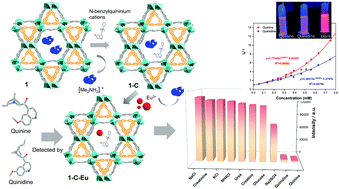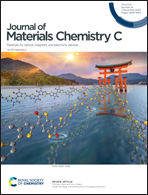A sensitive metal–organic framework nanosensor with cation-introduced chirality for enantioselective recognition and determination of quinine and quinidine in human urine†
Abstract
A post-synthetic modification (PSM) method has been employed to incorporate extra chiral binding sites into a chiral Cd-MOF [(CH3)2NH2][Cd(bpdc)1.5]·2DMA (1) (H2bpdc = 4,4′-biphenyldicarboxylate acid) to prepare a bifunctional MOF, 1-C-Eu. After PSM, the thermal and chemical stability of the parent framework is well preserved. More significantly, 1-C-Eu is designed to be a highly sensitive fluorescent probe that can be applied to the enantioselective recognition and determination of the chiral antimalarial drugs, quinine and quinidine. Many properties of the probe, including anti-interference ability, pH stability, reusability, and luminescence response speed, have been examined to evaluate the sensing performance of 1-C-Eu. In addition, the luminescent probe can be used to realize the detection of quinine and quinidine in human urine. The possible mechanism of distinguishing and sensing the epimers is also systematically discussed.



 Please wait while we load your content...
Please wait while we load your content...